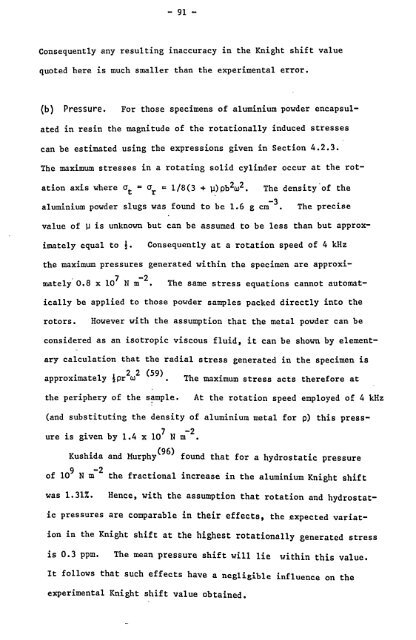NNR IN RAPIDLY ROTATED METALS By - Nottingham eTheses ...
NNR IN RAPIDLY ROTATED METALS By - Nottingham eTheses ...
NNR IN RAPIDLY ROTATED METALS By - Nottingham eTheses ...
Create successful ePaper yourself
Turn your PDF publications into a flip-book with our unique Google optimized e-Paper software.
- 91 -<br />
Consequently any resulting inaccuracy in the Knight shift value<br />
quoted here is much smaller than the experimental error.<br />
(b) Pressure. For those specimens of aluminium powder encapsul-<br />
ated in resin the magnitude of the rotationally induced stresses<br />
can be estimated using the expressions given in Section 4.2.3.<br />
The maximum stresses in a rotating solid cylinder occur at the rot-<br />
ation axis where at =r= 1/8(3 + u)pb2w2. The density'of the<br />
aluminium powder slugs was found to be 1.6 g cm 3.<br />
The precise<br />
value of u is unknown but can be assumed to be less than but approx-<br />
imately equal to 1. Consequently at a rotation speed of 4 kHz<br />
the maximum pressures generated within the specimen are approxi-<br />
mately 0.8 x 107 N m;<br />
-2 .<br />
The same stress equations cannot automat-<br />
ically be applied to those powder samples packed directly into the<br />
rotors. However with the assumption that the metal powder can be<br />
considered as an isotropic viscous fluid, it can be shown by element-<br />
ary calculation that the radial stress generated in the specimen is<br />
a roximatel<br />
22 (59)<br />
pp y Apr w The maximum stress acts therefore at<br />
the periphery of the sample. At the rotation speed employed of 4 kHz<br />
(and substituting the density of aluminium metal for p) this press-<br />
ure is given by 1.4 x 107 Nm2<br />
Kushida and Murphy (96)<br />
found that for a hydrostatic pressure<br />
of 109 Nm2 the fractional increase in the aluminium Knight shift<br />
was 1.31%. Hence, with the assumption that rotation and hydrostat-<br />
ic pressures are comparable in their effects, the expected variat-<br />
ion in the Knight shift at the highest rotationally generated stress<br />
is 0.3 ppm. The mean pressure shift will lie within this value.<br />
It follows that such effects have a negligible influence<br />
experimental Knight shift value obtained.<br />
on the

















